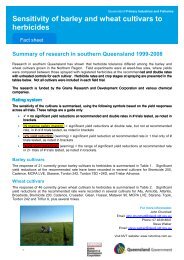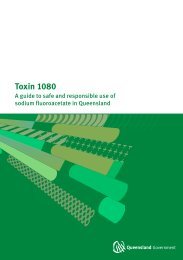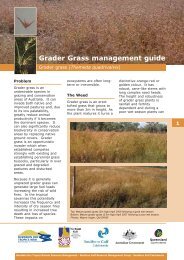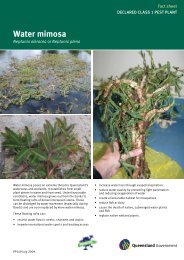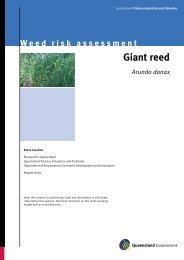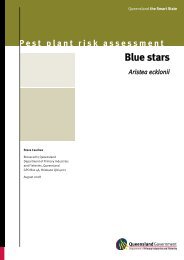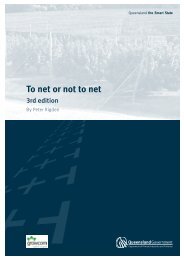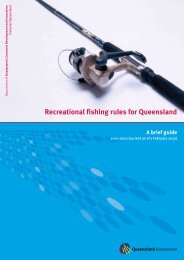The Australian ginger industry - Department of Primary Industries
The Australian ginger industry - Department of Primary Industries
The Australian ginger industry - Department of Primary Industries
Create successful ePaper yourself
Turn your PDF publications into a flip-book with our unique Google optimized e-Paper software.
Processing capacity<br />
Buderim Ginger has the capacity to process over 6000<br />
tonnes <strong>of</strong> raw <strong>ginger</strong> per annum; however, current storage<br />
capacity restricts processing capability to just over 3000<br />
tonnes per year for early harvest <strong>ginger</strong>.<br />
<strong>The</strong> quota arrangement<br />
A quota arrangement is in place between Buderim Ginger<br />
and <strong>ginger</strong> growers. <strong>The</strong> quota arrangement refers to a<br />
tonnage system whereby the grower has access to a market<br />
to supply a set volume that is agreed upon by both parties.<br />
Growers that supply Buderim Ginger receive a guaranteed<br />
price for the tonnage that they produce, providing it is<br />
accepted by the factory.<br />
<strong>The</strong>re are currently 20 registered quota holders in Queensland with a quota capacity totalling 3176<br />
tonnes, <strong>of</strong> which approximately 15 growers are currently supplying quota to Buderim Ginger. <strong>The</strong> number<br />
<strong>of</strong> quota holders has decreased since 2000, when 25 registered growers owned and supplied quota.<br />
From 2002 to 2007, the set price for quota equalled $1.10 per kilogram. In 2008, the set price increased by<br />
two cents to $1.12 per kilogram. Further increases have been negotiated and the set price will continue to<br />
increase by two cents each year until 2010.<br />
Each year Buderim Ginger conducts forecasts for raw <strong>ginger</strong> requirements and informs quota holders<br />
<strong>of</strong> the percentage <strong>of</strong> quota they are required to supply to the factory in the following season. All <strong>ginger</strong><br />
growers who supply the factory have entered into long-term contracts with the company. This gives the<br />
company a secure source <strong>of</strong> <strong>ginger</strong> and the growers a guaranteed market for their <strong>ginger</strong> quota. <strong>The</strong><br />
company holds some base quota, which is available to lease to potential growers in order to encourage<br />
new entrants on a small initial scale.<br />
In recent years a growing number <strong>of</strong> smaller and medium-sized growers have significantly decreased<br />
or completely ceased production. Where smaller growers have left the <strong>industry</strong>, larger growers have<br />
expanded their production operations—purchasing quota from those holders leaving the <strong>industry</strong>. Five<br />
growers currently lease quota from registered quota holders that are not fulfilling their quota requirement.<br />
<strong>The</strong>se growers each have their own individual arrangements in place for leasing quota.<br />
Buderim Ginger has suffered from a lack <strong>of</strong> local raw <strong>ginger</strong> supply in recent years, as many local<br />
producers have been unable to satisfy the quota requirements <strong>of</strong> the factory. As the number <strong>of</strong> quota<br />
holders supplying <strong>ginger</strong> to the factory has declined since 2000, the factory has requested growers<br />
supply volumes that exceed their quota allocation. Despite this, Buderim continues to experience<br />
problems with securing a sufficient supply <strong>of</strong> raw <strong>ginger</strong> from domestic producers.<br />
Buderim Ginger indicated the need to identify new areas to grow <strong>ginger</strong> in order to maintain a sustainable<br />
supply <strong>of</strong> raw <strong>ginger</strong> in the future. <strong>The</strong> Bundaberg and Atherton regions have been identified as possible<br />
locations where <strong>ginger</strong> production could be successful. A number <strong>of</strong> growers from the Bundaberg area<br />
have and will continue to supply <strong>ginger</strong>; however, volumes at this time remain relatively low. <strong>The</strong>re is<br />
no active <strong>ginger</strong> production taking place at Atherton. Further research and supply experience in <strong>ginger</strong><br />
production in these regions is required.<br />
Domestic and international markets<br />
Buderim Ginger has a strong export focus, with 60% <strong>of</strong> product manufactured being exported into foreign<br />
markets. Key export markets include the United Kingdom, Germany, Holland, Canada, the United States,<br />
New Zealand and South Korea. Products supplied to these markets are mostly ingredient-based for use<br />
by confectioners, bakers and other food manufacturers. <strong>The</strong> remaining 40% share is dedicated to the<br />
domestic market where product is distributed to retail supermarkets (Coles and Woolworths) and the food<br />
service and industrial sectors (Darrel Lea and Cotties).<br />
<strong>The</strong> <strong>Australian</strong> <strong>ginger</strong> <strong>industry</strong> Overview <strong>of</strong> market trends and opportunities 25





